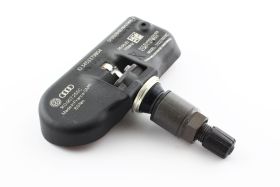The Voodoo behind TPMS with no Tire Pressure Sensors


In the year 2000 the TREAD act went into effect which mandated that all passenger vehicles must have tire pressure monitoring by the year 2007. One of the most prevalent driving forces of this act was the Ford Explorer/ Firestone tire blow out issue. Firestone contended that the lower tire pressure contributed to the blow outs in the Explorers.
The type of TPMS that most people are accustomed to is Direct TPMS. In this type of system you will have a tire pressure sensor mounted in each wheel. This sensor will send a signal to a tire pressure monitoring module inside the vehicle to receive the info with the tire pressure. This system can be problematic for many reasons, for example sensors may often be broken during tire replacement. Outside temperature can also affect these type of systems, since the pressure in your tire will drop as the outside air temp does you will often times get a low tire pressure light on a very cold morning. These sensors also have batteries that generally only last 4-7 years and will need to be replaced once they are dead.
Then came the dawn of Indirect TPMS, this measures tire pressure through the wheel speed sensors on the car. This system is called iTPMS and has had a few improvements in its short life.

Gen 1 of iTPMS used the wheel speed sensors in the ABS system to determine if 1 wheel was under inflated, by looking at the wheel speed in comparison to the others. If 1 wheel was under inflated it would cause that wheel and tire to be slightly smaller in over size, causing that wheel to have a high velocity that the other properly inflated wheels. This type of system has its limits as it may not be able to determine low tire pressure if all 4 tires are evenly low.
Gen 2 of iTPMS also uses the wheel speed sensor but has much more sophisticated programming which removes many of the limits of the previous system. This generation is capable of detecting as little as a 20% drop in tire pressure across all for wheels. This more sophisticated version of the iTPMS is not capable of monitoring actual (Live) tire pressure, which cannot be achieved without an actual sensor in the wheel.
What is that TPMS Reset button for?
On the Wheel Speed sensor based TPMS the vehicle needs a baseline to determine what a known good tire pressure looks like. The TPMS reset button is intended to be pressed after all tires have been set to the proper pressures. Once you adjust your tires to the proper pressures you press the button, then you must drive the vehicle to allow the vehicle to learn what the tires should look like. After pressing the reset button you should drive for 20-30 minutes (may vary by vehicle). This will allow the tire pressure system to learn your current settings.
Thanks for reading











Comments